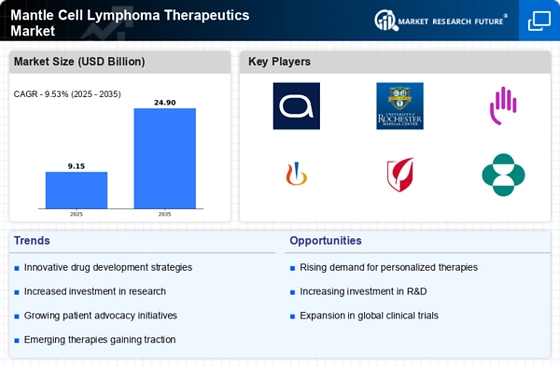The Mantle Cell Lymphoma Therapeutics Market is characterized by a dynamic competitive landscape, driven by innovation, strategic partnerships, and a focus on patient-centric solutions. Key players such as AbbVie (US), Roche (CH), and Novartis (CH) are at the forefront, each employing distinct strategies to enhance their market presence. AbbVie (US) emphasizes its commitment to research and development, particularly in novel therapies that target specific genetic mutations associated with mantle cell lymphoma. Roche (CH), on the other hand, leverages its extensive portfolio of monoclonal antibodies, focusing on combination therapies that enhance treatment efficacy. Novartis (CH) is actively pursuing regional expansion, particularly in emerging markets, to capitalize on the growing demand for innovative cancer therapies. Collectively, these strategies contribute to a competitive environment that is increasingly focused on personalized medicine and advanced therapeutic options.
In terms of business tactics, companies are increasingly localizing manufacturing and optimizing supply chains to enhance efficiency and reduce costs. The Mantle Cell Lymphoma Therapeutics Market appears moderately fragmented, with several key players exerting significant influence. This structure allows for a diverse range of treatment options, although it also necessitates strategic collaborations to maintain competitive advantage. The collective influence of these major players shapes market dynamics, as they vie for leadership through innovation and strategic positioning.
In August 2025, AbbVie (US) announced a collaboration with a leading biotechnology firm to develop a next-generation CAR T-cell therapy specifically targeting mantle cell lymphoma. This strategic move is likely to enhance AbbVie's portfolio and position it as a leader in advanced therapeutic options, potentially improving patient outcomes through more effective treatment modalities. The collaboration underscores the importance of partnerships in accelerating drug development and bringing innovative therapies to market.
In September 2025, Roche (CH) launched a new clinical trial for a combination therapy involving its flagship monoclonal antibody and a novel small molecule inhibitor. This initiative is significant as it aims to address treatment resistance in mantle cell lymphoma, a common challenge faced by oncologists. By exploring combination therapies, Roche is not only enhancing its product offerings but also reinforcing its commitment to addressing unmet medical needs in the oncology space.
In October 2025, Novartis (CH) expanded its manufacturing capabilities in Asia to meet the rising demand for its mantle cell lymphoma therapies. This strategic expansion is indicative of Novartis's proactive approach to supply chain optimization, ensuring that it can deliver therapies efficiently to a growing patient population. Such moves are essential in maintaining competitive differentiation in a market where timely access to innovative treatments is critical.
As of October 2025, current trends in the Mantle Cell Lymphoma Therapeutics Market include a strong emphasis on digitalization, sustainability, and the integration of artificial intelligence in drug development processes. Strategic alliances are increasingly shaping the competitive landscape, enabling companies to pool resources and expertise to accelerate innovation. Looking ahead, it appears that competitive differentiation will evolve from traditional price-based competition to a focus on technological advancements, innovative treatment solutions, and reliable supply chains. This shift may redefine how companies position themselves in the market, emphasizing the importance of agility and responsiveness to changing patient needs.


















Leave a Comment